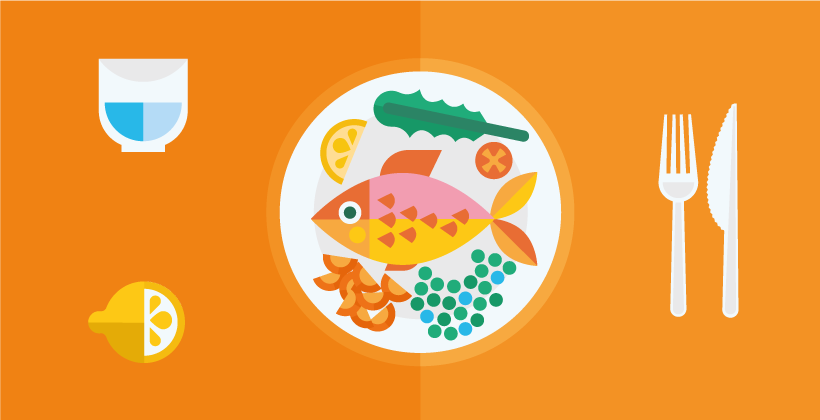The Food Pyramid: A Dietary Guideline in Europe
Last Updated : 01 October 2009Nowadays there is a mass of information and advice available from different sources about nutrition and health, and interested individuals can find details about the nutrients (e.g. carbohydrates, fat, protein, vitamins and minerals) they should be eating to achieve a healthy balanced diet. Food labels can also provide useful details on the amounts of the different nutrients contained in a food. However, the nutrient information available can seem quite complex, is not well understood by the majority of consumers, and it is of limited use when preparing family menus without a good knowledge of nutrition. This makes it necessary to provide nutrient advice in a way consumers can understand.
What are Food-Based Dietary Guidelines (FBDG)?
Food-based dietary guidelines (FBDG) are simple messages on healthy eating, aimed at the general public. They give an indication of what a person should be eating in terms of foods rather than nutrients, and provide a basic framework to use when planning meals or daily menus. Characteristics as described by the World Health Organization (WHO) are
- the expression of the principles of nutrition education mostly as foods.
- intended for use by individual members of the general public, and
- if not expressed entirely as foods, written in language that avoids, as far as possible, the technical terms of nutritional science.
FBDG should provide simple, food-based messages that are relevant to the population concerned and practical to follow. They can be broad and unspecific such as ‘eat a variety of foods each day’ or ‘eat plenty of fruits and vegetables’, or more specific such as ‘eat five portions of fruits and vegetables a day’. Messages may also indicate the type of food, such as ‘eat low fat dairy products and drink low fat milk’, or be meal specific such as ‘eat breakfast every day’.
FBDG avoid the use of numerical recommended intakes of nutrients (such as recommended daily allowances – RDA) or population targets, but provide a practical way of interpreting these into dietary advice for individuals within a population. So, if the population target for saturated fat is 10% of total energy, and the current intake is higher, messages will include those designed to reduce saturated fat intake, such as ‘choose lean cuts of meat’. FBDG also address public health concerns, such as chronic diseases, by targeting nutrients that may influence the disease outcome (e.g., messages to reduce saturated fat intake are given greater emphasis where rates of coronary heart disease are high).
The history of FBDG
Long before the discovery of the vitamins, their role in the body, and the establishment of food composition databases, people knew that different foods were important for health. Dietary recommendations were often based on observations, such as those of James Lind, a surgeon in the British navy during the 18th century who demonstrated that limes and oranges cured scurvy in sailors whereas other remedies such as vinegar and cider did not. Forty years after he published his findings all ships in the British navy were ordered to carry lime juice, and scurvy on board ships was virtually eradicated.
Since World War II, food based advice has been given to ensure adequate intakes of both macronutrients (proteins, carbohydrates, and fats) and micronutrients (vitamins and minerals), often using a system of food groupings. This involved placing foods with similar characteristics into the same food group and advising people to eat from each group every day. However, during the 1970s nutritionists became concerned with the over-consumption of fats, especially saturated fats, and sugars, and the lack of fibre in the diet. As a result, advice in developed countries tended to become more nutrient-based, with emphasis on macro- rather than micronutrients. This was mixed with some food-based advice to encourage eating more or less of those foods which were high or low in macronutrients of concern, but the use of traditional food groups became less popular.
Recognition of the value of FBDG
At an International Conference on Nutrition in Rome in 1992, a plan for action was adopted which called for the dissemination of nutrition information through sustainable food-based approaches that encourage dietary diversification through the production and consumption of micronutrient-rich foods, including appropriate traditional foods. The plan for action marked a change from policies dictated by numbers to policies focussing on prevailing public health problems. Following this, in 1996 the Food and Agricultural Organization (FAO) and the World Health Organization (WHO) of the United Nations published guidelines for the development of FBDG.2 Those guidelines remain the key reference work on the subject today.
The European International Life Sciences Institute (ILSI Europe) has organised two workshops focussing on FBDG. The first one was held in Vilnius (Lithuania) and Nitra (Slovakia) in 1997. It focussed on the ‘Development of local FBDG and nutrition education’. Seven years later, ILSI Europe, in collaboration with the FAO, organised a follow up workshop with 6 out of the 19 countries that participated in the first workshop. The focus was extended to also comprise the implementation and monitoring of FBDG. The document ‘National Food Based Dietary Guidelines: Experiences, Implications and Future Directions’ summarises the outcome of the workshop and shows the progress achieved by the 6 participating countries with regard to both the development and implementation of FBDG.3 A framework for FBDG in the European Union was agreed in 2000 as part of the Eurodiet project, and published in 2001.4
In 2003, the WHO assessed the existence of FBDG among the Member States of the WHO European Region. The results showed that out of the 48 participating countries, 25 had national FBDG that had been endorsed by the government. Another 8 countries reported that FBDG were in preparation.1
In March 2006, the European Food Safety Authority (EFSA) held a scientific colloquium in Parma on FBDG as a prelude to their task of providing guidance on the translation of nutrient-based recommendations for a healthy diet into food-based recommendations for the European Community.5 Prior to the scientific colloquium the EFSA Panel on Dietetic Products, Nutrition and Allergies reviewed the literature on the principles for developing FBDG, identified the necessary scientific information for establishing FBDG in European countries and summarised the steps for their implementation, monitoring and evaluation.6
In a separate parallel exercise, the European Commission (Research Directorate-General) funded the EURRECA (EURopean micronutrient RECommendations Aligned) Network of Excellence (2007-2011). The Network of Excellence is studying micronutrient requirements and the development of recommendations for vulnerable population groups. Hereby, it seeks to create tools which should help EFSA and other institutions charged with setting micronutrient recommendations. as well as guide the future development of FBDG in European countries. The aim of EURRECA is to produce Europe-wide scientific consensus on the evidence appropriate for developing micronutrient recommendations. This in turn should enable rapid and convenient translation into recommendations published in national policy documents.
The EURRECA Network, originally made up of 34 partners based in 17 countries, has a large involvement from academia, food industry (including small and medium sized enterprises), consumer groups, national nutrition societies and the health professions. The Network will be collaborating throughout this project with EFSA.7
In May 2009 the Food and Agricultural Organization of the United Nations (FAO) in collaboration with the European Food Information Council (EUFIC) organised a workshop on the development, communication and evaluation of FBDG. Fourteen Central and Eastern European countries participated in this workshop in Budapest.
Developing FBDG
In order to know which foods and food groups should be included in FBDG, it is necessary to assess the nutritional status of the target population. In some cases, this might be difficult to achieve, which is why provisional FBDG are built on other countries’ nutritional recommendations or FBDG, or on the World Health Organization’s dietary guide CINDI (Countrywide Integrated Noncommunicable Diseases Intervention).8 However, the evaluation of the nutritional status of a population is the best way to ensure that FBDG take into account the prevailing nutrient gaps and public health problems of a specific country.
In Europe, the main public health problems are diet- and lifestyle-related non-communicable conditions such as obesity, heart disease, diabetes and cancer. These diseases may partly derive from an excess intake of calorific nutrients and a shortage of certain micronutrients. For those reasons, FBDG need to consider both ‘negative’ (e.g. “choose lean cuts of meat” to reduce saturated fat intake) as well as ‘positive’ messages (e.g., “X portions of meat, poultry and fish per day” to increase iron intake).
The joint FAO/WHO consultation report ‘Preparation and Use of Food-Based Dietary Guidelines’ encourages the formation of a ‘Working group or committee, comprising representatives of agriculture, health, food science, nutritional science, consumers, the food industry, communication and anthropology’ as a first step in the development of FBDG.2 The process is highlighted both in the FAO/WHO report and in the EFSA Scientific Opinion from 2008, indicating the importance of involving people from different disciplines in the development.6 By doing this, one ensures that all relevant aspects of the different groups are taken into consideration. This increases the likelihood for success of the FBDG in addressing national health problems, and helps create greater awareness and acceptance of the guidelines among groups that might be involved in the dissemination, communication, and use of the FBDG.
In the EFSA Scientific Opinion seven steps for developing FBDG have been identified:
- Identification of diet-health relationships
- Identification of country specific diet-related problems
- Identification of nutrients of public health importance
- Identification of foods relevant for FBDG
- Identification of food consumption patterns
- Testing and optimising FBDG
- Graphical representation of FBDG
The Eurodiet report from 2000 also identifies five steps for developing FBDG. These are all contained in EFSA’s stepwise guide presented above.
The need for regular updates of the FBDG, and evaluation of their efficacy should also be considered in the development phase of the guidelines, so that sufficient resources are put aside from the start. Updates are essential to adapt the guidelines to the evolving scientific knowledge on the relationship between food, nutrition, and health, and to changing food habits and lifestyles. Evaluation of the guidelines’ effectiveness, for example by assessing the impact of the graphical representation and/or the messages on people’s behaviour, is necessary to further improve the communication strategy. The evaluation of FBDG is further discussed below.
Implementing FBDG
Once FBDG have been developed it is essential to develop communicative efforts that effectively inform the public on the FBDG messages. The joint FAO/WHO consultation report presents some factors to be taken into consideration in the implementation process2:
- FBDG messages should be short and clear, easily remembered, and comprehensible (understood by the general public). Visual materials used to communicate FBDG messages must also be clear and comprehensible to be successful. In addition, FBDG must be culturally acceptable as regards dietary habits, lifestyle etc. Radical changes to current habits will be less successful than recommendations on small changes, which will be easier to communicate and implement.
- Educational materials can be developed to support FBDG. The purpose of such material is to explain further the guideline’s content and its application in everyday life (explain portion size etc.). It is recommended that all relevant stakeholders are involved in producing education material since this enhances the materials’ quality.
- FBDG should be communicated through a wide selection of media. When a message is communicated several times, via different media, the message is reinforced and the impact will be more significant.
- Communication of FBDG should be targeted and address relevant community groups, age groups etc.
- FBDG should be practical, i.e. the foods recommended in FBDG must be affordable, accessible, and varied so that they suit different population groups. Unless FBDG are practical, they will not be used by the public.
- FBDG should be tested. First, nutritionists and consumer representatives (e.g. school teachers, community leaders) should check the guidelines. Upon revision made on the basis of this first testing, a second check with consumers should be performed to test their understanding.
In addition to this, the EFSA Scientific Opinion on FBDG also recommends integrating the FBDG into a ‘coherent food and nutrition policy’ that exceeds mere communication to consumers in order for the implementation to be effective.6
Evaluating FBDG
In the FAO/WHO consultation report, outcome and process evaluation are discussed. The purpose of outcome evaluation is to measure the results or impacts of the FBDG (knowledge, attitude, behaviour, practice etc.). This is mostly done using surveys. Process evaluation on the other hand entails assessing how a message is disseminated or implemented. The most important question to ask when carrying out such an evaluation is whether the communication campaign was implemented as planned. By evaluating the process, the outcomes are put into context. Hence, if the results from the outcome evaluation were disappointing, the process evaluation should yield information as to how to improve delivering the message in the future.2
For monitoring and evaluation, EFSA distinguishes between activity and effects, as opposed to FAO/WHO who only talk of outcome evaluation (in which both activity and effects are comprised). It is easier to monitor activity than effect, considering that indicators of activity are relatively easy to collect and quantify (e.g. numbers of brochures, leaflets that have been requested/disseminated/sold). Such data can be used to evaluate the awareness and knowledge of FBDG.6
The EFSA Scientific Opinion also lists ways of evaluating effects.6 The listed indicators do not have the same time scale in terms of follow-up, which needs to be taken into consideration when used.
- Changes in food sales/purchases. Note that such statistics may not paint a true picture of consumption, therefore one should be cautious when interpreting the data.
- Changes in food composition. FBDG can impact food composition by working as a driver for product reformulation. Monitoring of this is essential in that one must have knowledge about food composition to measure nutrient intake trends in the population.
- Changes in food/nutrient consumption. Indicators are obtained via representative dietary surveys.
- Changes in health status. Biomarkers, morbidity and mortality rates and more specific indicators can be used. In effect, to measure effectiveness of FBDG it is necessary to have the guidelines monitored and evaluated. The monitoring and evaluation results should then be used to improve the FBDG or the way they have been implemented.
FBDG in Europe
In this document, most examples of how FBDG may look and what kind of information they may contain are Western-European. Since Central- and Eastern–European FBDG tended to be developed later, and on the basis of the already existing FBDG, a selection of them can be found in the annex.
The majority of European countries have some form of FBDG.1 The guidelines are listed in Table 1 with information on their format and the advice covered. Nearly all guidelines include advice about foods containing fat, foods containing sugar and the consumption of fruits and vegetables. They also often contain advice on eating protein-containing foods, foods rich in carbohydrates and dietary fibre, restricting salt, taking enough fluids, controlling alcohol intake and body weight, and other aspects of lifestyle such as getting enough physical activity and eating regular meals. Occasionally they have advice on food hygiene.
Some countries, for example Italy and Denmark, have a list of food-based messages (see box below), while others present their FBDG in different graphic formats. Graphic formats are discussed in the next section.
|
Danish and Italian dietary advice to the population |
|---|
|
The Danish 8 diet tips
These tips are also listed in the Danish Food Compass. |
|
The Italian Guidelines
|
Graphic formats
Most countries have developed a graphic representation of FBDG to illustrate the proportions of different foods with similar characteristics that should be included in a balanced diet, although they may have a list of messages or tips as well. Graphic formats provide a consumer-friendly framework so that if foods from the main groups are eaten each day, an important first step is taken towards achieving a healthy diet, without specific knowledge of nutrients.
One of the earliest ways to group foods was on the basis of ‘plant-based foods’ and ‘animal-based foods’, as it was a division familiar to most people. The majority of the graphic FBDG further divide ‘animal-based foods’ into two separate groups:
- the ‘meat-related group’, also including fish, eggs, pulses, and in some cases nuts (e.g. Spain, Germany, Austria), especially important for iron intake;
- the ‘milk and dairy products group’, which is particularly important for calcium intake.
The inclusion of alternative non-animal foods in these groups is important for vegetarians.
Similarly, ‘plant-based foods’ are usually subdivided into:
- ‘cereals’ (including potatoes), which provide a fat free source of energy and certain types of fibre;
- ‘fruits and vegetables’, important for vitamin C as well as other micronutrients and protective elements.
Turkey’s graphic is, for example, made up of these four subgroups. Another group is sometimes created by separating ‘fruits’ and ‘vegetables’, as in the Portuguese, Greek and some Nordic guidelines.
Foods containing sugar feature as a separate group in some schemes but are mostly combined with fats and oils in a fatty and sugary food category that includes confectionery, bakery products and soft drinks. This group is always given a small proportion of the total to indicate that these foods should be eaten in much smaller amounts than the other groups which form the basis of a healthy diet. In some schemes, fats and oils form a group on their own and, in the FBDG developed for Greece and Spain, olive oil is highlighted to encourage its use over other fats.
Some guides also include fluids or water and physical activity as part of the graphic representation. Most guides include advice on these two aspects of a healthy lifestyle in the additional information that accompanies the graphic, such as text next to the graphic, a leaflet, a booklet, or a related website.
Food pyramids
The most popular graphic representation of FBDG is in the form of a pyramid. Austria, Belgium, Finland, Greece, Ireland, Latvia, Spain, Germany and Switzerland are some of the countries that make use of such a food guide pyramid.
The Irish food pyramid is typical in that it has five groups, each forming a layer. The base layer, across the widest part of the pyramid, is for the food group we should eat the greatest quantities of, i.e. ‘bread, cereal and potatoes’, and the narrow top depicts the group we should eat least of, i.e. ‘oils, fats and sugary foods’. Above the base layer are ‘fruits and vegetables’, the middle layer is ‘milk, cheese and yogurt’ and below the top layer is ‘meat, fish and alternatives’. Advice to drink plenty of water is given close by.
| Irish Food Pyramid |
|---|
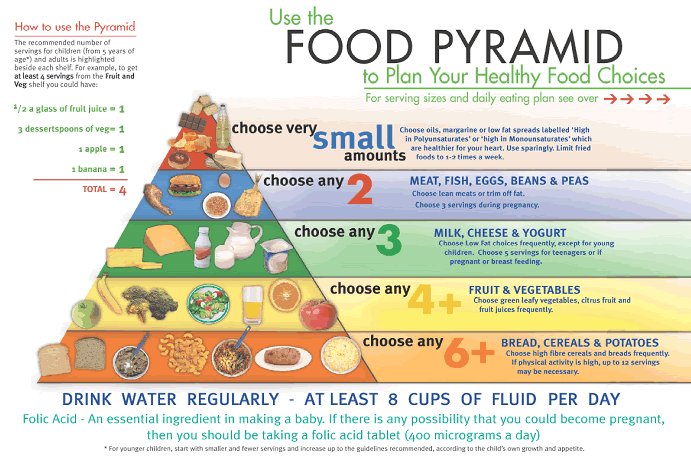 |
The Swiss pyramid differs from the Irish in that fruits and vegetables are in the layer below cereals, the milk and meat groups are combined in one layer and sugar-containing foods have a section of their own at the top above fats and oils.
| Swiss Food Pyramid |
|---|
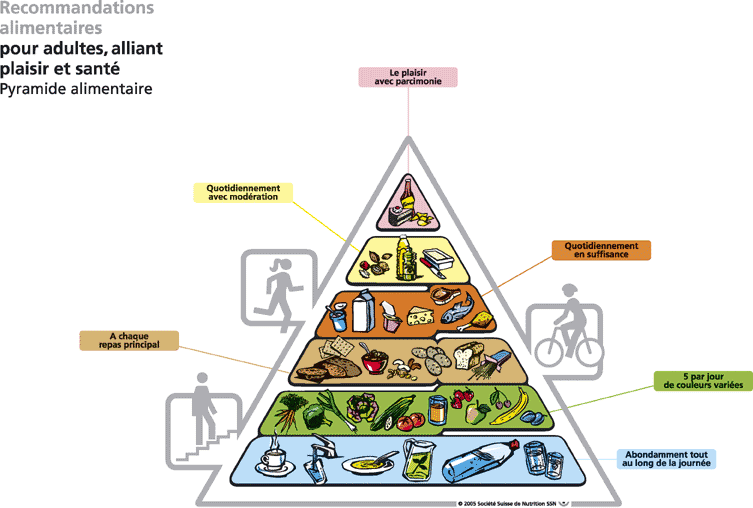 |
The Belgian and Swiss pyramids depict fluids as an additional food group at the base. In addition, both the Belgian and the Swiss includes physical activity in the graphic, but on the outside of the pyramid.
| Belgian Food Pyramid |
|---|
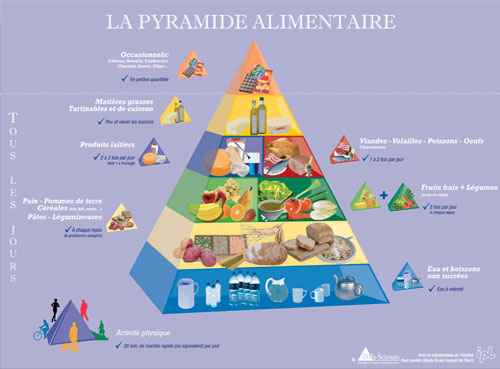 |
The Spanish pyramid adds water and exercise recommendations below the base of the graphic, and depicts advice for moderate intakes of wine and beer on the side of the pyramid.
| Spanish Food Pyramid |
|---|
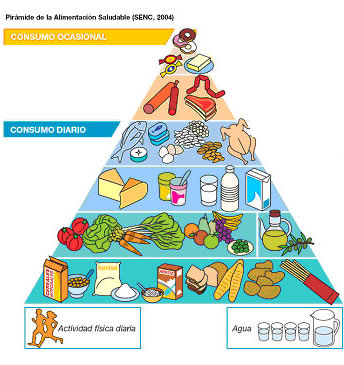 |
Both the Greek and Spanish food pyramids reflect local culture and health advice by including a small sub-section in the middle of their pyramids for olive oil.
| Greek Food Pyramid |
|---|
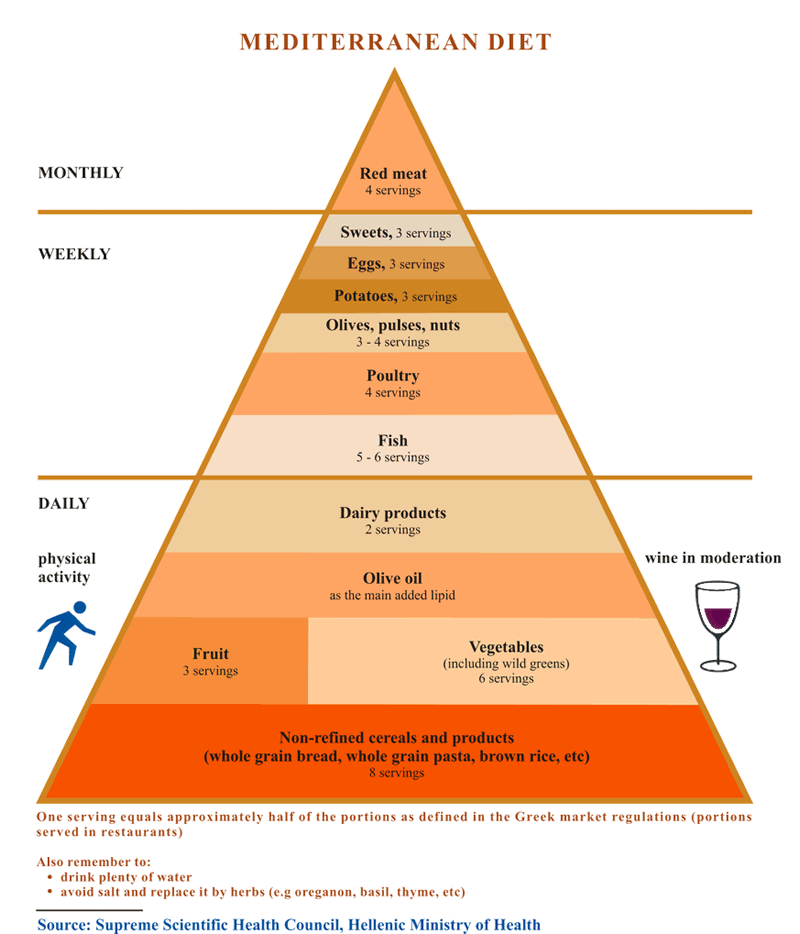 |
As all of the above examples, the Latvian graphic displays additional information on the side of the pyramid. Although here, percentages representing the ideal food groups’ contribution to a healthy diet are displayed. It also depicts fluids at the base of the pyramid.
| Latvian Food Pyramid |
|---|
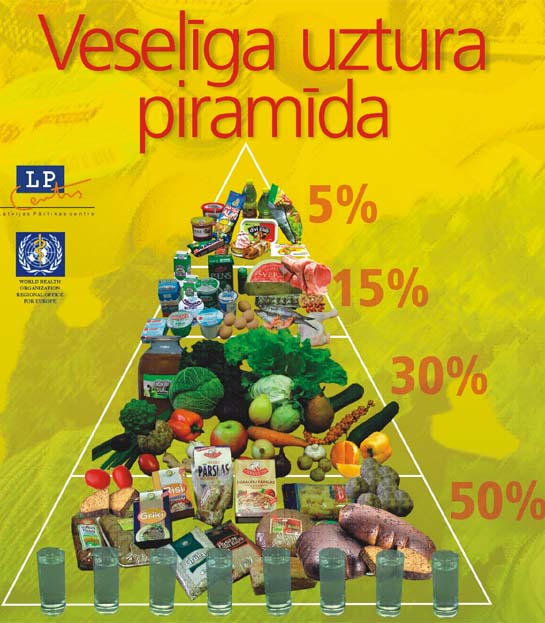 |
Germany uses a three-dimensional pyramid that provides qualitative (nutritional role of the food) as well as quantitative (how much of this food relative to others) advice on food consumption.
The four sides of the pyramid are dedicated to the following food groups:
- Foods primarily of plant origin; criteria for grouping at the base, middle or top of the pyramid being calorie density, nutrient density (vitamins, minerals, phytonutrients, fibre); preventive aspects (cancer, heart disease).
- Foods primarily of animal origin; criteria for grouping at the base, middle or top of the pyramid being calorie density, nutrient density (e.g., calcium, iron, zinc, selenium, B vitamins, vitamin D); fat quality (saturated fats, omega-3 fatty acids).
- Dietary fats and oils; positioning criteria for fats being: fatty acid composition omega-3, omega-6, omega-9 fatty acids, saturated fats, ratio of omega-6:omega-3 fatty acids); vitamin E; cholesterol; trans fats; application in cooking; criteria for oils: ratio of omega-6:omega-3 fatty acids; vitamin E content.
- Beverages; positioning criteria being: calorific value (moderate: 7% carbohydrates, high: 7% carbohydrates); essential nutrients; phytonutrients; stimulants; sweeteners.
The colours on the left of each of the four sides of the German pyramid are traffic lights that indicate the nutritional value of the foods and thereby give advice on the amounts to be consumed. The traffic lights apply to foods within the same food group.
The bottom of the 3D pyramid depicts a circle indicating the relative proportions of each group in the diet. For this, the plant-based foods are divided into ‘fruits and vegetables’ and ‘cereals’ and are given a much larger proportion of the circle than the animal-based foods. Fats are reduced to a very small proportion of the whole and water fills the centre.
| German Food Pyramid |
|---|
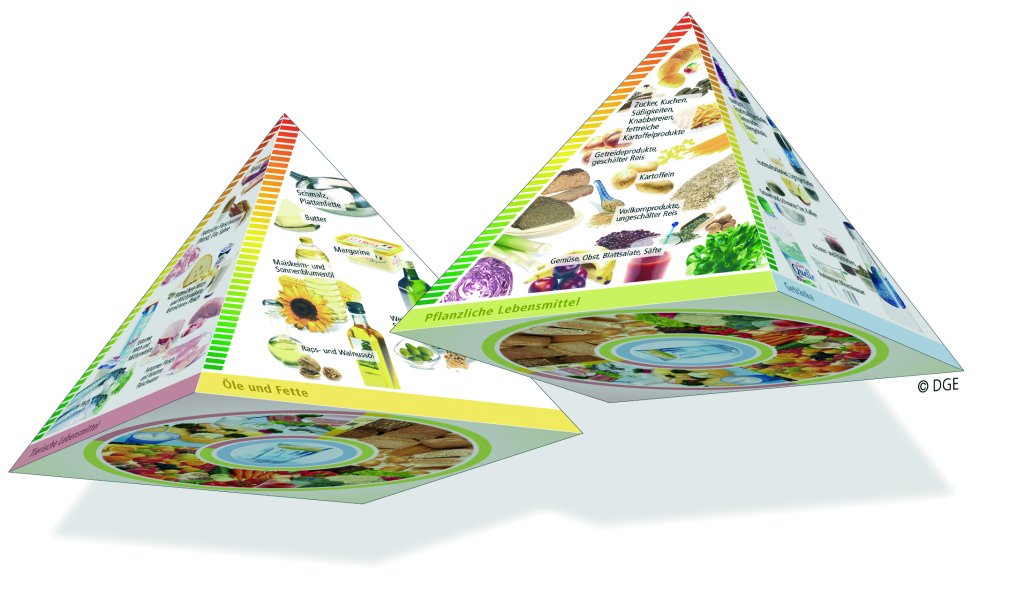 |
The Austrian pyramid, like the Belgian and Swiss pyramids, depicts fluids as an additional food group at the base of a two-dimensional graphic, and it differs from the Irish in that fruits and vegetables are one layer below cereals, the milk and meat groups are combined in one layer and foods containing sugar have a section of their own at the top above fats and oils.
| Austrian Food Pyramid |
|---|
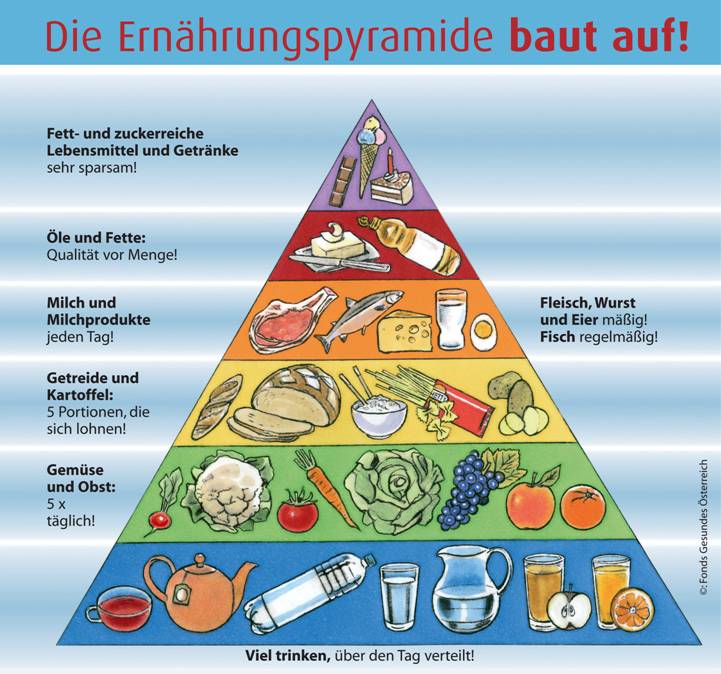 |
WHO Europe has developed the CINDI pyramid (from the Countrywide Integrated Non communicable Disease Intervention programme).8 The particularity of this pyramid is the use of colour codes such as the ones used in a traffic light scheme. The green colour is found at the base of the pyramid (cereals, fruits and vegetables) and hence indicates that those foods should constitute the largest part of the diet. Milk and dairy products and meat, fish and eggs are in the orange, middle part of the pyramid. The orange colour signifies that only moderate amounts of these foods are needed for a healthy balanced diet. Red is found at the top of the pyramid, covering fat, oils and sugars. The red colour informs people that only very small amounts of these foods are needed.
| CINDI Food Pyramid |
|---|
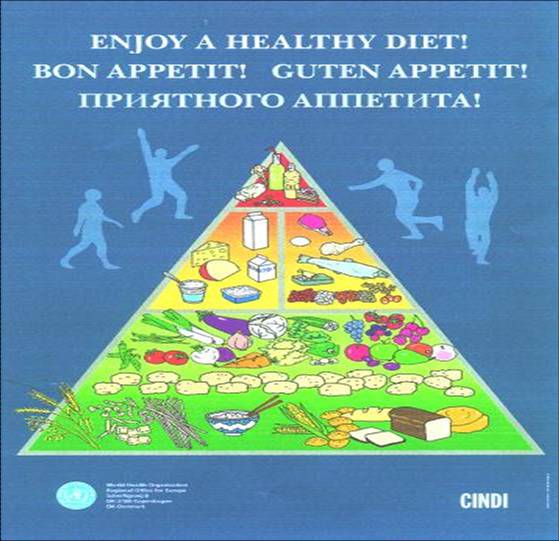 |
Food circles
The other common graphical form used for FBDG in Europe is a circle divided into segments like a cake. Each segment contains one food group similar to those used in the pyramids. Circles have been developed in Portugal, Sweden and the UK (depicted as a plate). Finland and Spain use a circle as well as the pyramid, and the German pyramid depicts a circle at the base of its 3D pyramid. The Netherlands have a wheel, the centre of which is used for food messages. Most circles are proportionally segmented in accordance with the recommended contributions from each food group. The Portuguese and German graphics have water at the centre of the circle whilst the Spanish circle depicts both water and exercise at the centre.
| The eatwell plate (UK) | The Spanish wheel |
|---|---|
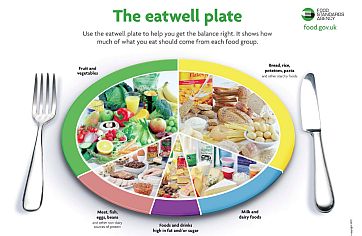 |
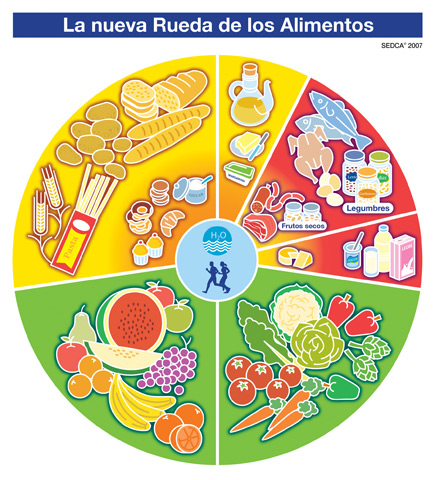 |
Other visual cues
Pictures of examples from each food groups are generally included within each food group either as photographs or drawings. A considerable amount of care and attention has to go into the choice and design of the pictures to ensure that typical foods are included, that nothing important is omitted, that there is a good mix for the local culture and that they are visually appealing. Where fluid and physical activity are included in the graphic, they are done so by illustrations.
Most of the time, different colours are used for different groups without a specific meaning, with some exceptions (e.g. the CINDI pyramid described above, and the German pyramid where colours indicate the quality of the different products found within a food group).
In Hungary, the guide is accompanied by a graphic in the shape of a house with the ground floor, first floor, roof and chimney depicting different food groups. The French FBDG are illustrated as stairs. Foods from which higher amounts can be consumed are found at the top of the stairs, whilst the ones that should only be consumed in small quantities are found at the bottom.
The French guidelines are also shown in a table containing recommendations on the amount of each of the six food groups, salt and fluids that should be consumed. The table also displays recommendations on physical activity.
| Hungarian house |
|---|
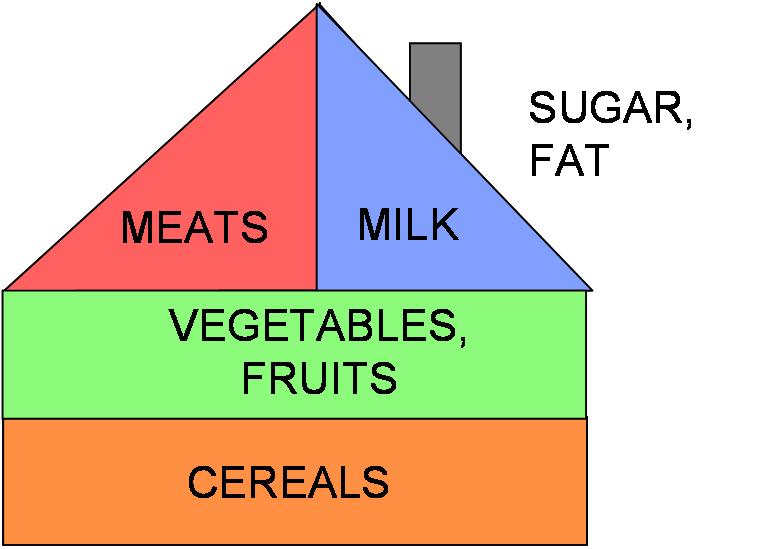 |
| French Stairs |
|---|
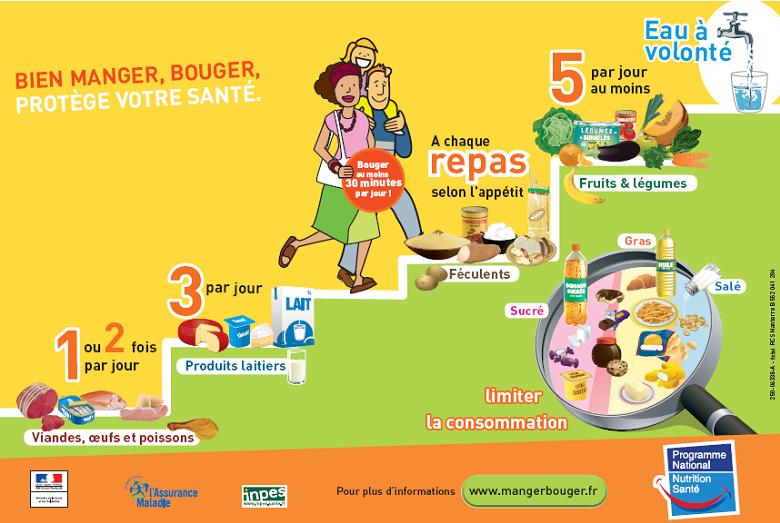 |
Additional information
Although graphical formats of FBDG are generally designed to stand on their own, some additional text is generally needed for clarification. This can take the following formats:
- Text designed to be part of the graphic. This includes using the names of the food groups (as in the UK plate) or the foods within the group (e.g. German 3D pyramid), or the recommended number of servings (e.g. Irish pyramid).
- Text placed close to the graphic either on a poster, simple leaflet or on the same web page. This text gives further information and advice on the types of foods and quantities to be consumed for each group as well as additional tips which may also include advice on fluids, alcohol, physical activity and body weight.
- A more detailed leaflet, small booklet or website giving further information and advice, including some information on nutrients.
- A larger booklet which goes beyond the FBDG with more details on diet and nutrition, suitable for health professionals, teachers and interested consumers.
Some potential issues with graphic FBDG
FBDG are not an exact science but guidelines to help people manage and improve the quality of their diet. Graphical representations, with a minimum amount of text, are helpful but may imply that everyone should eat exactly the same amount from each food group every day.
As individuals, we do not all have exactly the same dietary needs and more than one dietary pattern is consistent with good health. Individuals should be aiming for the balance suggested over a period of several days or weeks. This also allows for foods that should not be eaten daily to have a place in the diet.
Graphic FBDG have still to resolve how to deal with mixed dishes and convenience foods. For example, where do foods such as pizza and French fries fit in the scheme?
| American Food Pyramid |
|---|
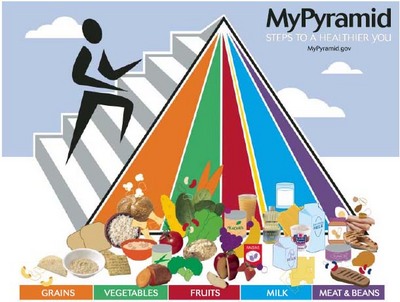 |
Although the pyramid is the most common format, it has been criticised by some for making the sugary/fatty foods that we should eat only small amounts of, appear more important by placing them at the top. The recently revised American ‘My Pyramid’ has completely changed the display, so that the food groups are presented vertically instead of horizontally, all starting at the base and meeting at the point in the top.9 Consequently, the stripes delimiting the food groups are wider at the bottom and narrower at the top, ostensibly to drive home the idea that not all foods within a group are of the same value. It reminds us to eat mostly foods without solid fats and added sugars. Foods such as sweets and cakes are not included in the graphic and are called ‘discretionary foods’.
In each country a considerable amount of effort is put into making FBDG relevant to national public health issues, and to make nutrient recommendations simple to understand and visually appealing for consumers. However, there has been little research into the effect FBDG have on what people eat.
Conclusions
Nearly all European countries have developed FBDG. They are all based on the principle to provide guidance for a healthy balanced diet that will help prevent non-communicable diseases such as heart disease and cancer. Common recommendations include eating plenty of fruits, vegetables and complex carbohydrates, and choosing foods which are lower in saturated fat, salt and sugar. The use of food groups, as in food pyramids and circles, ensures the inclusion of all basic foods and gives positive messages about what we should be eating as well as some qualifying information to help us avoid eating too much of certain foods. Although the details may vary – FBDG have been developed by different bodies at different times and for use in different cultures – there are many similarities between all the European FBDG.
Eurodiet, EFSA and FAO/WHO provide guidance on the development, implementation and evaluation of FBDG. Key elements in the development phase are that nutrient gaps, likely intakes, typical foods and proper choice ranges are identified prior to formulating FBDG. For effective implementation, FBDG messages should be practical and their communication short, comprehensible and culturally accepted to ensure a broad uptake by the public. The latter can be enhanced through repeated, targeted communications via diverse media channels. Monitoring changes in food composition, consumption patterns and public health status will help evaluate FBDG effectiveness and make appropriate adjustments.
References
- World Health Organisation European Region. Food based dietary guidelines in the WHO European Region. Copenhagen: WHO, Europe, 2003
- Food and Agricultural Organization, World Heath Organisation. Preparation and use of Food-Based Dietary Guidelines. Report of a joint FAO/WHO consultation. Nicosia, Cyprus: WHO, 1996 - www.fao.org/docrep/X0243E/x0243e00.htm
- International Life Sciences Institute (ILSI) Europe. National Food Based Dietary Guidelines: Experiences, Implications and Future Directions. Summary Report of a Workshop held on 28-30 April 2004 in Budapest, Hungary.
- Gibney MJ, Sandstrom B. A framework for food-based dietary guidelines in the European Union. Public Health Nutrition 2001;4:293-305.
- European Food Safety Authority. Development of Food-based Dietary Guidelines. EFSA Scientific Colloquium No 5 Summary Report. Parma, Italy: EFSA, 2007
- European Food Safety Authority. Scientific Opinion of the Panel on Dietetic Products, Nutrition and Allergies on a request from the EC on Food-Based Dietary Guidelines. Question No EFSQ-Q-2005-015c. Agreed on 2 July 2008 for release for public consultation
- The EURRECA Network of Excellence is funded by the European Commission Contract n° FP6 036196-2 FOOD
- World Health Organisation European Region. CINDI dietary guide. Copenhagen: WHO, Europe, 2000.
- United States Department of Agriculture.

